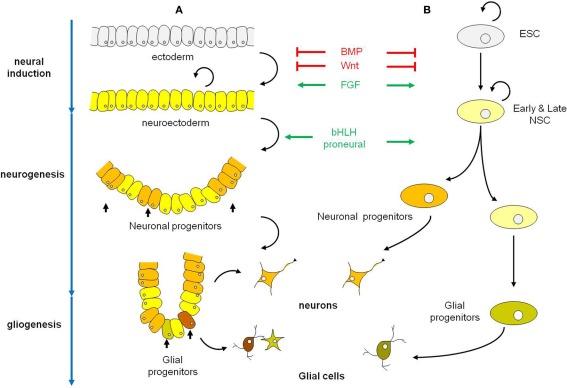Figure 1.
Schematic representations of the early phases of neural development in the embryo (A) and in Esc (B). (A) Neural induction which converts ectoderm into neuroectoderm is regulated by the coordinated actions of BMP, Wnt, and FGF signaling pathways. Neuroectodermal cells are undifferentiated dividing neuroepithelial cells that will latter differentiate into neurons (neurogenesis period) and in a second phase into glial cells (gliogenesis period). Among the factors that control the selection of neuronal progenitors from the neuroectodermal cells and their commitment to differentiate along the neuronal lineage are the proneural bHLH genes. In vertebrates, proneural bHLH genes are first expressed in the neuroectodermal cells, already committed to the neural fate. The neuronal progenitors have a limited mitotic potential. Differentiation occurs in a defined temporal sequence, neurons being generated first, followed by glial cells. The switch from neurogenesis to gliogenesis is controlled by both extrinsic and intrinsic signals and is the result of changes in the progenitor properties within the same pool of neuronal progenitors. (B) In ESC neural induction and specification of ES-derived neural progenitors follow the same cues as in the embryo to give rise to populations of neurons and glial cells. Black curved arrows indicate self-renewing cells. Abbreviations: BMP, bone morphogenetic protein; bHLH genes, basic helix-loop-helix genes; ESC, embryonic stem cell; NSC, neural stem cell.

